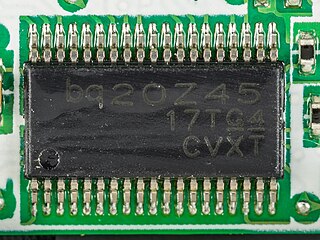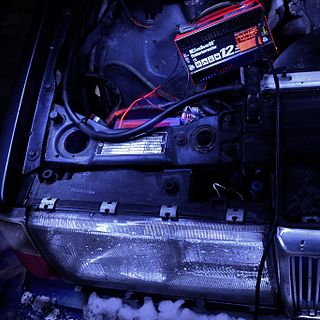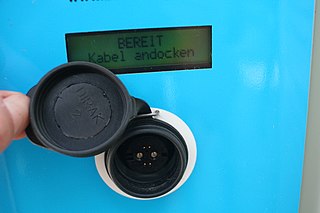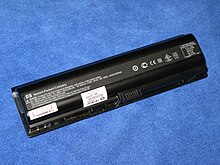
I2C (Inter-Integrated Circuit; pronounced as “eye-squared-C”), alternatively known as I2C or IIC, is a synchronous, multi-master/multi-slave (controller/target), single-ended, serial communication bus invented in 1982 by Philips Semiconductors. It is widely used for attaching lower-speed peripheral ICs to processors and microcontrollers in short-distance, intra-board communication.

A rechargeable battery, storage battery, or secondary cell, is a type of electrical battery which can be charged, discharged into a load, and recharged many times, as opposed to a disposable or primary battery, which is supplied fully charged and discarded after use. It is composed of one or more electrochemical cells. The term "accumulator" is used as it accumulates and stores energy through a reversible electrochemical reaction. Rechargeable batteries are produced in many different shapes and sizes, ranging from button cells to megawatt systems connected to stabilize an electrical distribution network. Several different combinations of electrode materials and electrolytes are used, including lead–acid, zinc–air, nickel–cadmium (NiCd), nickel–metal hydride (NiMH), lithium-ion (Li-ion), lithium iron phosphate (LiFePO4), and lithium-ion polymer.

A DC connector is an electrical connector for supplying direct current (DC) power.
The System Management Bus is a single-ended simple two-wire bus for the purpose of lightweight communication. Most commonly it is found in chipsets of computer motherboards for communication with the power source for ON/OFF instructions. The exact functionality and hardware interfaces vary with vendors.
RS-485, also known as TIA-485(-A) or EIA-485, is a standard, originally introduced in 1983, defining the electrical characteristics of drivers and receivers for use in serial communications systems. Electrical signaling is balanced, and multipoint systems are supported. The standard is jointly published by the Telecommunications Industry Association and Electronic Industries Alliance (TIA/EIA). Digital communications networks implementing the standard can be used effectively over long distances and in electrically noisy environments. Multiple receivers may be connected to such a network in a linear, multidrop bus. These characteristics make RS-485 useful in industrial control systems and similar applications.

Smart Battery System (SBS) is a specification for managing a smart battery, usually for a portable computer. It allows operating systems to perform power management operations via a smart battery charger based on remaining estimated run times by determining accurate state of charge readings. Through this communication, the system also controls the battery charge rate. Communication is carried over an SMBus two-wire communication bus. The specification originated with the Duracell and Intel companies in 1994, but was later adopted by several battery and semiconductor makers.

A battery pack is a set of any number of (preferably) identical batteries or individual battery cells. They may be configured in a series, parallel or a mixture of both to deliver the desired voltage, capacity, or power density. The term battery pack is often used in reference to cordless tools, radio-controlled hobby toys, and battery electric vehicles.

A battery charger, recharger, or simply charger, is a device that stores energy in a battery by running an electric current through it. The charging protocol depends on the size and type of the battery being charged. Some battery types have high tolerance for overcharging and can be recharged by connection to a constant voltage source or a constant current source, depending on battery type. Simple chargers of this type must be manually disconnected at the end of the charge cycle. Other battery types use a timer to cut off when charging should be complete. Other battery types cannot withstand over-charging, becoming damaged, over heating or even exploding. The charger may have temperature or voltage sensing circuits and a microprocessor controller to safely adjust the charging current and voltage, determine the state of charge, and cut off at the end of charge. Chargers may elevate the output voltage proportionally with current to compensate for impedance in the wires.
The Power Management Bus (PMBus) is a variant of the System Management Bus (SMBus) which is targeted at digital management of power supplies. Like SMBus, it is a relatively slow speed two wire communications protocol based on I²C. Unlike either of those standards, it defines a substantial number of domain-specific commands rather than just saying how to communicate using commands defined by the reader.

A charge controller, charge regulator or battery regulator limits the rate at which electric current is added to or drawn from electric batteries to protect against electrical overload, overcharging, and may protect against overvoltage. This prevents conditions that reduce battery performance or lifespan and may pose a safety risk. It may also prevent completely draining a battery, or perform controlled discharges, depending on the battery technology, to protect battery life. The terms "charge controller" or "charge regulator" may refer to either a stand-alone device, or to control circuitry integrated within a battery pack, battery-powered device, and/or battery charger.

The Display Serial Interface (DSI) is a specification by the Mobile Industry Processor Interface (MIPI) Alliance aimed at reducing the cost of display controllers in a mobile device. It is commonly targeted at LCD and similar display technologies. It defines a serial bus and a communication protocol between the host, the source of the image data, and the device which is the destination. The interface is closed source, which means that the specification of the interface is not open to the public. The maintenance of the interface is the responsibility of the MIPI Alliance. Only legal entities can be members. These members or the persons commissioned and approved by them have access to the specification in order to use it in their possible applications.
Host Embedded Controller Interface (HECI) is technology introduced in 2006 used for Active Management Technology (AMT) in Intel chipsets that support Core 2 Duo microprocessors.
MIPI Alliance is a global business alliance that develops technical specifications for the mobile ecosystem, particularly smart phones but including mobile-influenced industries. MIPI was founded in 2003 by Arm, Intel, Nokia, Samsung, STMicroelectronics and Texas Instruments.
A battery management system (BMS) is any electronic system that manages a rechargeable battery, such as by protecting the battery from operating outside its safe operating area, monitoring its state, calculating secondary data, reporting that data, controlling its environment, authenticating it and / or balancing it.

Battery balancing and battery redistribution refer to techniques that improve the available capacity of a battery pack with multiple cells and increase each cell's longevity. A battery balancer or battery regulator is an electrical device in a battery pack that performs battery balancing. Balancers are often found in lithium-ion battery packs for laptop computers, electrical vehicles. etc.

EnergyBus connectors are used for charging electric bicycles and pedelecs within Europe. The connector is circular in shape and specified for charging light electric vehicles at up to 1.5 kilowatts. Electric power is provided at 12–48 volts direct current (DC) so that any battery charger can charge any rechargeable battery.
Management Component Transport Protocol (MCTP) is a protocol designed by the Distributed Management Task Force (DMTF) to support communications between different intelligent hardware components that make up a platform management subsystem, providing monitoring and control functions inside a managed computer system. This protocol is independent of the underlying physical bus properties, as well as the data link layer messaging used on the bus. The MCTP communication model includes a message format, transport description, message exchange patterns, and operational endpoint characteristics.
An Embedded Controller (EC) is a microcontroller in computers that handles various system tasks. Now it is usually merged with Super I/O, especially on mobile platforms.

I3C is a specification to enable communication between computer chips by defining the electrical connection between the chips and signaling patterns to be used. Short for "Improved Inter Integrated Circuit", the standard defines the electrical connection between the chips to be a two wire, shared (multidrop), serial data bus, one wire (SCL) being used as a clock to define the sampling times, the other wire (SDA) being used as a data line whose voltage can be sampled. The standard defines a signalling protocol in which multiple chips can control communication and thereby act as the bus controller.












